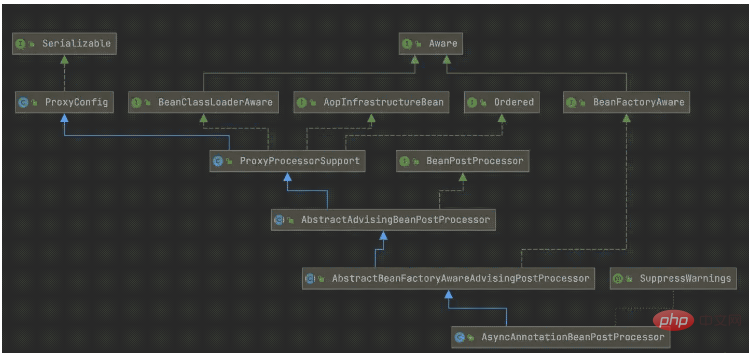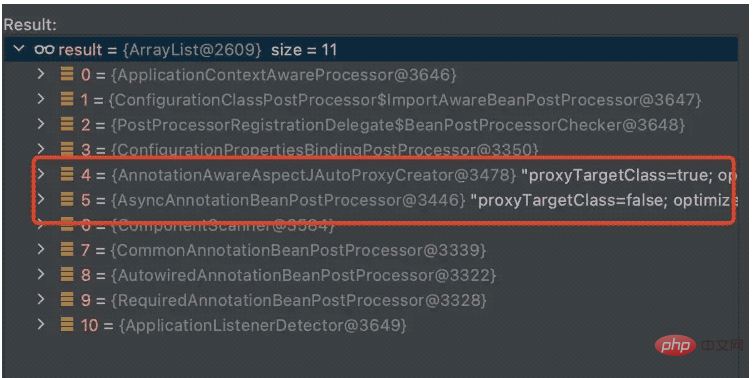Some time ago, a colleague told me that her project could not be started, and asked me to take a look at it. In the spirit of helping others With a happy spirit, I must help you with this.
So, I found the following exception information in her console:
Exception in thread "main" org.springframework.beans.factory.BeanCurrentlyInCreationException: Error creating bean with name 'AService': Bean with name 'AService' has been injected into other beans [BService] in its raw version as part of a circular reference, but has eventually been wrapped. This means that said other beans do not use the final version of the bean. This is often the result of over-eager type matching - consider using 'getBeanNamesOfType' with the 'allowEagerInit' flag turned off, for example.
at org.springframework.beans.factory.support.AbstractAutowireCapableBeanFactory.doCreateBean( AbstractAutowireCapableBeanFactory.java:602)
at org.springframework.beans.factory.support.AbstractAutowireCapableBeanFactory.createBean(AbstractAutowireCapableBeanFactory.java:495)
at org.springframework.beans.factory.support.AbstractBeanFactory.lambda$doGetBean$0 (AbstractBeanFactory.java:317)
at org.springframework.beans.factory.support.DefaultSingletonBeanRegistry.getSingleton(DefaultSingletonBeanRegistry.java:222)
My first thought was when I saw the BeanCurrentlyInCreationException exception The reaction is that there is a circular dependency problem. But if you think about it carefully, hasn't Spring already solved the problem of circular dependencies? Why is this error still reported? So, I asked the lady what she had changed, and she said that she added the @Async annotation to the method.
Here I simulate the code at that time. AService and BService refer to each other, and the save() method of AService is annotated with @Async.
@Component
public class AService {
@Resource
private BService bService;
@Async
public void save() {
}
}
@Component
public class BService {
@Resource
private AService aService;
}That is, this code will report a BeanCurrentlyInCreationException exception. Could it be that when the @Async annotation encounters a circular dependency, Spring cannot solve it? In order to verify this conjecture, I removed the @Async annotation and started the project again, and the project was successful. So we can basically conclude that when the @Async annotation encounters a circular dependency, Spring cannot solve it.
Although the cause of the problem has been found, the following questions have arisen:
How does the @Async annotation work?
Why is Spring unable to resolve the circular dependency encountered by the @Async annotation?
How to solve the problem of circular dependency exception?
The @Async annotation is implemented by the AsyncAnnotationBeanPostProcessor class, which handles the @Async annotation. Objects of the AsyncAnnotationBeanPostProcessor class are injected into the Spring container by the @EnableAsync annotation. This is the fundamental reason why the @EnableAsync annotation needs to be used to activate the @Async annotation.

Class system
This class implements the BeanPostProcessor interface and the postProcessAfterInitialization method, which is implemented in its parent class AbstractAdvisingBeanPostProcessor , that is to say, the postProcessAfterInitialization method of AsyncAnnotationBeanPostProcessor will be called back after the initialization phase of the Bean is completed. The reason for the callback is that in the Bean life cycle, when the Bean initialization is completed, the postProcessAfterInitialization method of all BeanPostProcessor will be called back. The code is as follows:
@Override
public Object applyBeanPostProcessorsAfterInitialization(Object existingBean, String beanName)throws BeansException {
Object result = existingBean;
for (BeanPostProcessor processor : getBeanPostProcessors()) {
Object current = processor.postProcessAfterInitialization(result, beanName);
if (current == null) {
return result;
}
result = current;
}
return result;
}AsyncAnnotationBeanPostProcessor For the postProcessAfterInitialization method implementation:
@Override
public Object postProcessAfterInitialization(Object bean, String beanName) {
if (this.advisor == null || bean instanceof AopInfrastructureBean) {
// Ignore AOP infrastructure such as scoped proxies.
return bean;
}
if (bean instanceof Advised) {
Advised advised = (Advised) bean;
if (!advised.isFrozen() && isEligible(AopUtils.getTargetClass(bean))) {
// Add our local Advisor to the existing proxy's Advisor chain...
if (this.beforeExistingAdvisors) {
advised.addAdvisor(0, this.advisor);
}
else {
advised.addAdvisor(this.advisor);
}
return bean;
}
}
if (isEligible(bean, beanName)) {
ProxyFactory proxyFactory = prepareProxyFactory(bean, beanName);
if (!proxyFactory.isProxyTargetClass()) {
evaluateProxyInterfaces(bean.getClass(), proxyFactory);
}
proxyFactory.addAdvisor(this.advisor);
customizeProxyFactory(proxyFactory);
return proxyFactory.getProxy(getProxyClassLoader());
}
// No proxy needed.
return bean;
}The main function of this method is to dynamically proxy the object entered as a parameter. When the class of the object entered as a parameter is annotated with @Async, then this method will dynamically proxy the object and finally return it. The proxy object of the parameter object goes out. As for how to determine whether the method is annotated with @Async, it is determined by isEligible(bean, beanName). Since this code involves the underlying knowledge of dynamic agents, it will not be elaborated here.

The role of AsyncAnnotationBeanPostProcessor
To sum up, we can draw a conclusion that when the initialization phase is completed during the Bean creation process, AsyncAnnotationBeanPostProcessor will be called. The postProcessAfterInitialization method performs a dynamic proxy on the object of the class annotated with @Async, and then returns a proxy object.
虽然这里我们得出@Async注解的作用是依靠动态代理实现的,但是这里其实又引发了另一个问题,那就是事务注解@Transactional又或者是自定义的AOP切面,他们也都是通过动态代理实现的,为什么使用这些的时候,没见抛出循环依赖的异常?难道他们的实现跟@Async注解的实现不一样?不错,还真的不太一样,请继续往下看。
我们都知道AOP是依靠动态代理实现的,而且是在Bean的生命周期中起作用,具体是靠 AnnotationAwareAspectJAutoProxyCreator 这个类实现的,这个类会在Bean的生命周期中去处理切面,事务注解,然后生成动态代理。这个类的对象在容器启动的时候,就会被自动注入到Spring容器中。
AnnotationAwareAspectJAutoProxyCreator 也实现了BeanPostProcessor,也实现了 postProcessAfterInitialization 方法。
@Override
public Object postProcessAfterInitialization(@Nullable Object bean, String beanName) throws BeansException {
if (bean != null) {
Object cacheKey = getCacheKey(bean.getClass(), beanName);
if (!this.earlyProxyReferences.contains(cacheKey)) {
//生成动态代理,如果需要被代理的话
return wrapIfNecessary(bean, beanName, cacheKey);
}
}
return bean;
}通过 wrapIfNecessary 方法就会对Bean进行动态代理,如果你的Bean需要被动态代理的话。

AnnotationAwareAspectJAutoProxyCreator作用
也就说,AOP和@Async注解虽然底层都是动态代理,但是具体实现的类是不一样的。一般的AOP或者事务的动态代理是依靠 AnnotationAwareAspectJAutoProxyCreator 实现的,而@Async是依靠 AsyncAnnotationBeanPostProcessor 实现的,并且都是在初始化完成之后起作用,这也就是@Async注解和AOP之间的主要区别,也就是处理的类不一样。
Spring在解决循环依赖的时候,是依靠三级缓存来实现的。我曾经写过一篇关于三级缓存的文章,如果有不清楚的小伙伴可以 关注微信公众号 三友的java日记,回复 循环依赖 即可获取原文链接,本文也算是这篇三级缓存文章的续作。
简单来说,通过缓存正在创建的对象对应的ObjectFactory对象,可以获取到正在创建的对象的早期引用的对象,当出现循环依赖的时候,由于对象没创建完,就可以通过获取早期引用的对象注入就行了。
而缓存ObjectFactory代码如下:
addSingletonFactory(beanName, () -> getEarlyBeanReference(beanName, mbd, bean));
protected void addSingletonFactory(String beanName, ObjectFactory singletonFactory) {
Assert.notNull(singletonFactory, "Singleton factory must not be null");
synchronized (this.singletonObjects) {
if (!this.singletonObjects.containsKey(beanName)) {
this.singletonFactories.put(beanName, singletonFactory);
this.earlySingletonObjects.remove(beanName);
this.registeredSingletons.add(beanName);
}
}
}所以缓存的ObjectFactory对象其实是一个lamda表达式,真正获取早期暴露的引用对象其实就是通过 getEarlyBeanReference 方法来实现的。
getEarlyBeanReference 方法:
protected Object getEarlyBeanReference(String beanName, RootBeanDefinition mbd, Object bean) {
Object exposedObject = bean;
if (!mbd.isSynthetic() && hasInstantiationAwareBeanPostProcessors()) {
for (BeanPostProcessor bp : getBeanPostProcessors()) {
if (bp instanceof SmartInstantiationAwareBeanPostProcessor) {
SmartInstantiationAwareBeanPostProcessor ibp = (SmartInstantiationAwareBeanPostProcessor) bp;
exposedObject = ibp.getEarlyBeanReference(exposedObject, beanName);
}
}
}
return exposedObject;
}getEarlyBeanReference 实现是调用所有的 SmartInstantiationAwareBeanPostProcessor 的 getEarlyBeanReference 方法。
而前面提到的 AnnotationAwareAspectJAutoProxyCreator 这个类就实现了 SmartInstantiationAwareBeanPostProcessor 接口,是在父类中实现的:
@Override
public Object getEarlyBeanReference(Object bean, String beanName) throws BeansException {
Object cacheKey = getCacheKey(bean.getClass(), beanName);
if (!this.earlyProxyReferences.contains(cacheKey)) {
this.earlyProxyReferences.add(cacheKey);
}
return wrapIfNecessary(bean, beanName, cacheKey);
}这个方法最后会调用 wrapIfNecessary 方法,前面也说过,这个方法是获取动态代理的方法,如果需要的话就会代理,比如事务注解又或者是自定义的AOP切面,在早期暴露的时候,就会完成动态代理。
这下终于弄清楚了,早期暴露出去的原来可能是个代理对象,而且最终是通过AnnotationAwareAspectJAutoProxyCreator这个类的getEarlyBeanReference方法获取的。
但是AsyncAnnotationBeanPostProcessor并没有实现SmartInstantiationAwareBeanPostProcessor,也就是在获取早期对象这一阶段,并不会调AsyncAnnotationBeanPostProcessor处理@Async注解。
这里我们就拿前面的例子来说,AService加了@Async注解,AService先创建,发现引用了BService,那么BService就会去创建,当Service创建的过程中发现引用了AService,那么就会通过AnnotationAwareAspectJAutoProxyCreator 这个类实现的 getEarlyBeanReference 方法获取AService的早期引用对象,此时这个早期引用对象可能会被代理,取决于AService是否需要被代理,但是一定不是处理@Async注解的代理,原因前面也说过。
于是BService创建好之后,注入给了AService,那么AService会继续往下处理,前面说过,当初始化阶段完成之后,会调用所有的BeanPostProcessor的实现的 postProcessAfterInitialization 方法。于是就会回调依次回调 AnnotationAwareAspectJAutoProxyCreator 和 AsyncAnnotationBeanPostProcessor 的 postProcessAfterInitialization 方法实现。
这段回调有两个细节:
AnnotationAwareAspectJAutoProxyCreator 先执行,AsyncAnnotationBeanPostProcessor 后执行,因为 AnnotationAwareAspectJAutoProxyCreator 在前面。

AnnotationAwareAspectJAutoProxyCreator处理的结果会当入参传递给 AsyncAnnotationBeanPostProcessor,applyBeanPostProcessorsAfterInitialization方法就是这么实现的
AnnotationAwareAspectJAutoProxyCreator回调:会发现AService对象已经被早期引用了,什么都不处理,直接把对象AService给返回
AsyncAnnotationBeanPostProcessor回调:发现AService类中加了@Async注解,那么就会对AnnotationAwareAspectJAutoProxyCreator返回的对象进行动态代理,然后返回了动态代理对象。
这段回调完,是不是已经发现了问题。早期暴露出去的对象,可能是AService本身或者是AService的代理对象,而且是通过AnnotationAwareAspectJAutoProxyCreator对象实现的,但是通过AsyncAnnotationBeanPostProcessor的回调,会对AService对象进行动态代理,这就导致AService早期暴露出去的对象跟最后完全创造出来的对象不是同一个,那么肯定就不对了。
同一个Bean在一个Spring中怎么能存在两个不同的对象呢,于是就会抛出BeanCurrentlyInCreationException异常,这段判断逻辑的代码如下:
if (earlySingletonExposure) {
// 获取到早期暴露出去的对象
Object earlySingletonReference = getSingleton(beanName, false);
if (earlySingletonReference != null) {
// 早期暴露的对象不为null,说明出现了循环依赖
if (exposedObject == bean) {
// 这个判断的意思就是指 postProcessAfterInitialization 回调没有进行动态代理,如果没有那么就将早期暴露出去的对象赋值给最终暴露(生成)出去的对象,
// 这样就实现了早期暴露出去的对象和最终生成的对象是同一个了
// 但是一旦 postProcessAfterInitialization 回调生成了动态代理 ,那么就不会走这,也就是加了@Aysnc注解,是不会走这的
exposedObject = earlySingletonReference;
}
else if (!this.allowRawInjectionDespiteWrapping && hasDependentBean(beanName)) {
// allowRawInjectionDespiteWrapping 默认是false
String[] dependentBeans = getDependentBeans(beanName);
Set actualDependentBeans = new LinkedHashSet<>(dependentBeans.length);
for (String dependentBean : dependentBeans) {
if (!removeSingletonIfCreatedForTypeCheckOnly(dependentBean)) {
actualDependentBeans.add(dependentBean);
}
}
if (!actualDependentBeans.isEmpty()) {
//抛出异常
throw new BeanCurrentlyInCreationException(beanName,
"Bean with name '" + beanName + "' has been injected into other beans [" +
StringUtils.collectionToCommaDelimitedString(actualDependentBeans) +
"] in its raw version as part of a circular reference, but has eventually been " +
"wrapped. This means that said other beans do not use the final version of the " +
"bean. This is often the result of over-eager type matching - consider using " +
"'getBeanNamesOfType' with the 'allowEagerInit' flag turned off, for example.");
}
}
}
} 所以,之所以@Async注解遇上循环依赖,Spring无法解决,是因为@Aysnc注解会使得最终创建出来的Bean,跟早期暴露出去的Bean不是同一个对象,所以就会报错。
解决这个问题的方法很多
1、调整对象间的依赖关系,从根本上杜绝循环依赖,没有循环依赖,就没有早期暴露这么一说,那么就不会出现问题
2、不使用@Async注解,可以自己通过线程池实现异步,这样没有@Async注解,就不会在最后生成代理对象,导致早期暴露的出去的对象不一样
3、可以在循环依赖注入的字段上加@Lazy注解
@Component
public class AService {
@Resource
@Lazy
private BService bService;
@Async
public void save() {
}
}4、从上面的那段判断抛异常的源码注释可以看出,当allowRawInjectionDespiteWrapping为true的时候,就不会走那个else if,也就不会抛出异常,所以可以通过将allowRawInjectionDespiteWrapping设置成true来解决报错的问题,代码如下:
@Component
public class MyBeanFactoryPostProcessor implements BeanFactoryPostProcessor {
@Override
public void postProcessBeanFactory(ConfigurableListableBeanFactory beanFactory) throws BeansException {
((DefaultListableBeanFactory) beanFactory).setAllowRawInjectionDespiteWrapping(true);
}
}虽然这样设置能解决报错的问题,但是并不推荐,因为这样设置就允许早期注入的对象和最终创建出来的对象是不一样,并且可能会导致最终生成的对象没有被动态代理。
The above is the detailed content of How to solve the pitfall of using @Async annotation in spring boot project. For more information, please follow other related articles on the PHP Chinese website!